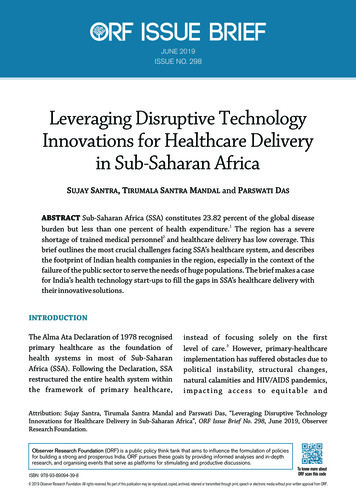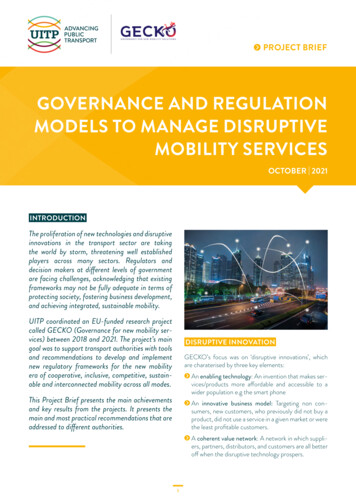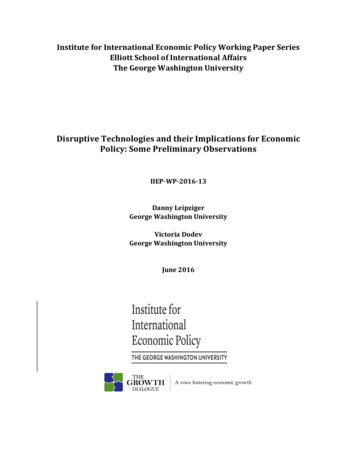
Transcription
JUNE 2019ISSUE NO. 298Leveraging Disruptive TechnologyInnovations for Healthcare Deliveryin Sub-Saharan AfricaSUJAY SANTRA, TIRUMALA SANTRA MANDAL and PARSWATI DASABSTRACT Sub-Saharan Africa (SSA) constitutes 23.82 percent of the global disease1burden but less than one percent of health expenditure. The region has a severeshortage of trained medical personnel2 and healthcare delivery has low coverage. Thisbrief outlines the most crucial challenges facing SSA’s healthcare system, and describesthe footprint of Indian health companies in the region, especially in the context of thefailure of the public sector to serve the needs of huge populations. The brief makes a casefor India’s health technology start-ups to fill the gaps in SSA’s healthcare delivery withtheir innovative solutions.INTRODUCTIONThe Alma Ata Declaration of 1978 recognisedprimary healthcare as the foundation ofhealth systems in most of Sub-SaharanAfrica (SSA). Following the Declaration, SSArestructured the entire health system withinthe framework of primary healthcare,instead of focusing solely on the first3level of care. However, primary-healthcareimplementation has suffered obstacles due topolitical instability, structural changes,natural calamities and HIV/AIDS pandemics,impacting access to equitable andAttribution: Sujay Santra, Tirumala Santra Mandal and Parswati Das, “Leveraging Disruptive TechnologyInnovations for Healthcare Delivery in Sub-Saharan Africa”, ORF Issue Brief No. 298, June 2019, ObserverResearch Foundation.Observer Research Foundation (ORF) is a public policy think tank that aims to influence the formulation of policiesfor building a strong and prosperous India. ORF pursues these goals by providing informed analyses and in-depthresearch, and organising events that serve as platforms for stimulating and productive discussions.ISBN 978-93-89094-39-8 2019 Observer Research Foundation. All rights reserved. No part of this publication may be reproduced, copied, archived, retained or transmitted through print, speech or electronic media without prior written approval from ORF.
Leveraging Disruptive Technology in Sub-Saharan Africa’s Primary Healthcare Delivery Systemsustainable care and the health outcomes ofthe people.4Barriers to Effective Care in SSAmodels that lack focus on disease prevention,promotion components, workforce training,s t ro n g s u p e r v i s i o n a nd m a n a g e r i a lleadership.101. Insufficient access to primary care:Primary healthcare systems are governed by aset of policies regarding universal health5coverage and primary care. In SSA, only onethird of the region has access to affordablebasic healthcare, and the workforce is a fractionof the total size required, causing multiplehealth challenges.6 The subregion's publicagenda does not sufficiently includeprevention and treatments. The region hasexperienced drastic changes in health anddisease patterns, and has a high predominanceof communicable diseases, non-communicablediseases, and infectious and parasitediseases.7,8,9 While the public health system iscrucial in addressing the healthcare gap, therehas been little progress over the years, due tothe continuation of colonial-era healthcare2. S h o r t a g e o f h e a l t h w o r k f o r c e :Community health workers form importantlinkages to essential life-saving healthcareintervention. SSA consists of 11 percent of theworld’s population and bears 24 percent of theglobal disease burden, but it is home to only11three percent of the global health workforce.The World Health Organization (WHO)estimates that 57 countries worldwide face acritical shortage of health workers, out ofwhich 36 countries are in SSA.12,13 The lack ofhealth resources has negative implications onpublic health with respect to increasedmortality rates, maternal and child health andthe treatment of AIDS, which further limits thecapacity of various interventions and theimplementation of government healthpolicies, given the scale of health workforce14,15disparity.Figure 1: Current Density of Physicians, Nurses and Midwives, and the Required Rate of WorkforceGrowth According to Population Growth Rates, in 12 African Countries16Source: WHO, 2009.2ORF ISSUE BRIEF No. 298lJUNE2019
Leveraging Disruptive Technology in Sub-Saharan Africa’s Primary Healthcare Delivery System3. Information technology for clinical use:Harnessing the power of informationtechnology can significantly improve thehealth system’s capacity to streamline patientdatabase and provide better clinical care and17drug management. However, due to thedisproportionate burden of diseases, SSA lagsbehind in the adoption of innovativetechnology. A study reported that the use ofElectronic Health Records in SSA wasrecommended for the AIDS Relief HIVprogramme, but limited computer skills andhuman resources hindered properimplementation.18,19 So far, technology hasremained confined to administrative and nonclinical usage.THE GROWTH OF PRIVATEHEALTHCARE IN AFRICAThe weak national health systems in Africapaved the way for private players to gain newfootholds in the continent. In countries withlimited public resources, 60 percent of thehealthcare financing is dependent on privatehealth services and 50 percent of the totalexpenditure goes to private health providers.20Most citizens—especially in rural communities—have been underserved by the public sector,creating opportunities for private players to fillthe gap with high-quality, frequent services andadvanced resources.Renewed political stability, economicreforms and increasing average incomes haveexpanded the healthcare gap, creating greaterdemand for quality care. In 2001, Africa’sannual GDP growth was at five percent, fasterthan the global average of 4.2 percent, withSSA’s per capita growth exceeding five percent21in the last five years. This allowed forORF ISSUE BRIEF No. 298lJUNE2019improved per-capita expenditure on healthcaregoods and services. The highest share ofinvestment has come from private healthcaresectors, such as medical product manufacturer,pharmaceutical, retail, insurance, medicaleducation and technology-enabled healthcareinitiatives.INDIA–AFRICA HEALTHCARERELATIONSIndian Pharmaceutical Businesses in SSAIndia is SSA’s second-largest pharmaceuticaltrading partner, followed by China, which isgrowing at a rate of 6.4 percent of the total22global trade. Southern and Western Africa, inparticular, are the largest importers ofIndian pharmaceutical products. Indianmanufacturers gain market share primarilythrough cost-effective pricing and by targetingdifferent markets. For example, Ranbaxy,Cipla and Dr. Reddy have a strong presence inEast Africa23 and have gained a competitiveadvantage over other global players in theregion by integrating local talent in businessoperations and offering quality medicines24certified by WHO.Before 2001, only one in a thousand hadaccess to life-saving antiretroviral (ARV)medicines, critical for preventing thetransmission of HIV/AIDS. During that time,the biggest pharmaceutical companies offeredthe medicine at a price point of US 10,000–15,000 per patient per year. Recognising theneed for affordable medicines in the region,Indian pharmaceutical companies, such asCipla, disrupted the market price to offer thedrug at US 350 per person per year, and later,Mylan and Aurobindo reduced the cost toUS 75 per person per year.253
Leveraging Disruptive Technology in Sub-Saharan Africa’s Primary Healthcare Delivery SystemTable 1: Key Pharmaceutical Companies in Sub-Saharan AfricaPharmaceuticalFirmsAreas of OperationInitiativesCipla Ltd.Cameroon, Kenya,Lesotho, ZambiaCipla’s “Dollar a Day” Treatment Programme offerstriple-combination of “antiretroviral” AIDS drugs atUS 350 per person per year, which is less than 1 aday per patient to provide critical medicines topoor nations at an affordable price. It hasrevolutionised the way AIDS drugs are offered inAfrica.Dr. Reddy’sLaboratoriesSouth AfricaThe pharma company is a wholly owned subsidiaryand a leading generic player in South Africa andfocuses on key therapeutic areas such as CentralNervous System (CNS) and Primary Care. Thecompany commenced operations in the continentthrough Triomed.RanbaxyLaboratoriesOperates in 52countries in the Africancontinentand the Middle Eastand is strengthening itsmanufacturingcapacities in NigeriaRanbaxy Laboratories boosted its presence in theemerging market of Africa by introducing a newmalaria-fighting drug, “Synriam,” and setting upmanufacturing facilities in Morocco, Nigeria andSouth Africa.IPCA LaboratoriesUganda, Ghana, IvoryCoast, Burkina Faso,Zimbabwe, Sudan,Tanzania, Kenya,Ethiopia and NigeriaIPCA exports branded and generic formulations, aswell as Active PharmaceuticalIngredients (APIs).Cadila HealthcareSouth AfricaThe company is amongst the top ten Indian privatepharmaceutical companies operating in the Africangeneric drugs market. Subsidiary companies ofCadila working in Africa include SimaylaPharmaceuticals (Pty) Ltd. (South Africa), ZydusHealthcare S.A. (Pty) Ltd. (South Africa), and ScriptManagement Services (Pty) Ltd. (South Africa).J.B. Chemicals andPharmaceuticalsLtd. (JBCPL)South AfricaManufactures and markets a diverse range ofpharmaceutical formulations, herbal remedies andAPIs.Lupin Ltd.South AfricaThe single-largest company in the cardiovascularsegment. It is a major generic pharmaceuticalplayer in South Africa.Source: RIS New Delhi, 2015.264ORF ISSUE BRIEF No. 298lJUNE2019
Leveraging Disruptive Technology in Sub-Saharan Africa’s Primary Healthcare Delivery SystemAfter 2001, several Indian pharmaceuticalcompanies entered SSA’s healthcare market toride its growth wave. It was evident that theywould only be able to develop and expand inthe continent through healthcare providerpartnerships. For instance, in 2009, a CAD50million equity fund made an investment inNairobi, acquiring a stake in a women’s27hospital, and worked with local organisationsto reach more patients to provide healthcareservices and medicine supplements. Aninitiative in India implemented by Novartis, inpartnership with local NGOs, earned increaseddemand for medicines by encouraging rural28families to seek health advice.The Entry of Indian Private HealthcarePlayers in SSAincomes enabled Indian healthcare partners toput down roots and offer cheaper healthcarecompared to private African healthcareproviders. Prior to this, Africa’s own healthsystems catered primarily to the affluentpopulations and restricted care to acute and29short-term treatment. A majority of Africancitizens—especially the poor and those in themiddle-income bracket—relied on underfunded public health facilities, with only asmall minority having access to well-funded,private health systems. Consequently, therewas an urgent demand for improved access toprimary healthcare. Indian health providersmanaged to fill this gap by providingtreatments at lower costs and catering to alarger patient base, while also improving theirprofit margins.The expansion of SSA’s pharmaceuticalmarket and the region’s improved averageTable 2 shows key Indian secondary andtertiary healthcare providers in SSA.30,31Table 2: Indian Private Healthcare Service Providers in SSACOMPANYAREAS OF INTERVENTION DOMAINAga KhanNairobiUniversity HospitalDue to increasingly frequent non-communicableillnesses, including cancer, they are looking toprovide specialist care.Medanta AfricareKenya, NairobiTertiary careFortis HealthcareUganda and NigeriaTertiary careAgarwal’s EyeHospitalsMauritius , Ghana andMozambiqueAdvanced diagnostics and eye-care treatment withoptical facilityApollo HealthcareNigeria, South Africa,Mauritius, Ethiopia,Tanzania andZimbabweTertiary careMoolchandHealthcareNigeria, South Africa,Mauritius, Ethiopia,Tanzania andZimbabweTertiary careORF ISSUE BRIEF No. 298lJUNE20195
Leveraging Disruptive Technology in Sub-Saharan Africa’s Primary Healthcare Delivery SystemIPE AfricaKenya, Ethiopia,Tanzania, Rwanda,Somalia, DemocraticRepublic of Congo,Ghana and ZimbabweFocused on building local capacities, strengtheninghealth systemsIndian healthcare providers soon realisedthat specialised services are domain-specificand fail to cater to vulnerable populations.The private players were observed to work insilos and lacked integrated technologysolutions, limiting their impact, scale andreach of service delivery to certain geographicregions. Further, the expansion andreplication of Indian models for affordabledelivery proved difficult in Africa for severalreasons:1. Tertiary healthcare provision is moreexpensive in Africa, e.g. an open-heartprocedure at leading private hospitals inNairobi costs as much as US 15,000,while it can be availed at US 2,000 in32India.2. Insurance penetration is lower than onepercent in more than half of the33continent.3. Community health workers charge morethan their Indian counterparts.344. A d v a n c e d d i a g n o s t i c s a n dcomprehensive treatments are merelypresent or fragmented in nature, makingit difficult to replicate Indian prices in6Africa, unless they adapt to the localmarket context.In light of these challenges, a model thatcombines the health workforce, technologyinnovations and health-reform integrationcan help the Indian health systems scale upmore effectively in African countries.35Healthcare delivery in SSA is uncoordinated,and hospitals and specialist care are accessibleonly to the affluent population due to highcosts. There is a dearth of integrated primaryhealthcare delivery systems, which can act asthe first point of access to medical care and,later, to secondary and tertiary care across theregion. For instance, common illnesses can bemanaged at the primary level and complexdisorders referred to specialists by the primarymedical team, ensuring that patients receivethe most appropriate care in a systematicmanner. This coordinated continuum of carecan help reduce the costs of secondarytreatments and alleviate inequality and36vulnerability. Sub-Saharan African countrieshave now committed themselves to reviewingand updating their health policies to keep upwith the regional goal of accomplishing healthfor all through the primary-healthcare model.37ORF ISSUE BRIEF No. 298lJUNE2019
Leveraging Disruptive Technology in Sub-Saharan Africa’s Primary Healthcare Delivery SystemTable 3: Health-Tech Companies Operating in Africa's Primary Healthcare DomainDomainName C40Medic41MobileAreaFor Last Frontline End-to- Innovative Continuum OccasioningProfit Mile HealthPOCEndof CarewithWorkers TechnologyModelBacked byGovt.IntegrationAILiving Goods operatesUganda Nonnetworks of independentandProfitentrepreneurs who make a Kenya Organisationliving by selling medicinesand products to poorpeople that can helpimprove their health,wealth and productivity.Plan to deploy thousands ofdigitally empowered CHWsto deliver quality care,door-to-door, at a fractionof the cost of trainingdoctors or nurses.Supports the governmentto implement anationwide communityhealth-worker programmethat will bring life-savingcare to the doorsteps ofpeople living in nity-basedHealthcareLiberia, NonUganda ProfitIntegrated communityhealth systems thatimprove the quality,accessibility, speed, andequity of primaryhealthcareLiberia, NonUganda, ProfitKenya,Ethiopia,MalawiCommcare- A unique feature of ICTDimagi42 enabled data collection isthat data can be viewedand analysed in real time,so that care providers andpolicymakers can makelife-saving decisions basedon evidenceORF ISSUE BRIEF No. 298lJUNE2019SouthForAfrica , profitMaputo,Mozambique,andDakar,Senegal,Tanzania7
Leveraging Disruptive Technology in Sub-Saharan Africa’s Primary Healthcare Delivery SystemINDIAN HEALTHCARE START-UPS INAFRICAExtending the reach of primary care andrenewing its framework requires a systemicapproach on several fronts, including newdelivery models; a greater role of privateinitiatives; and the introduction of digitaltechnology to improve access to care andknowledge, and create collaborations between43key stakeholders.Mobile phones have become increasinglycommon and can be used as important tools ind e l i v e r i n g b e t te r h e a l t h o u tco m e s .Entrepreneurial ventures with technologysolutions are emerging to connect thehealthcare gaps in the continent.44 Whilemany of these ventures are in their nascentstages, they are already creating a significantimpact in African communities. For example,a longitudinal study conducted by a start-upventure called “Healthy Entrepreneur” inKenya, in association with ErasmusUniversity Rotterdam, observed significantimprovement in knowledge and access to basiccare delivered through entrepreneurialinitiatives, compared to non-entrepreneurs.The study demonstrated a 52-percent increasein knowledge, 80-percent increase in access toessential health products and generic drugs,and 17–25-percent reduction in overallmarket price. The study also showed thatentrepreneurial initiatives provide morereliable services to the community while stillgenerating profit. They spend more time incommunity work and increasing thepopulation’s self-esteem.While technology penetration has pickedup rapidly, the continent is yet to establish e45health programmes. However, the study8finds that SSA is open to mainstreaming ehealth as a major component of its healthstrateg y. Recently, multiple m-healthinterventions have been pilot tested in thecontinent across various fields, such asmaternal and child health intervention,telemedicine, remote consultations, referrals,supply-chain management, and technologyenabled health workforce.Despite the immense opportunity thatSSA presents for health-tech companies,however, prominent Indian health-techplayers are still few and far between.Case 1: Bharti Airtel LimitedBharti Airtel Limited is an Indian globaltelecommunications services company, and itis Africa’s largest mobile carrier. The MalawiMinistry of Health has discovered aninnovative way to provide importanthealthcare services to rural people through theuse of text messages called “health centres byphone.” A mobile handset becomes a clinic thattransmits information to patients withoutthem having to visit a clinic. The text messages er v ice als o prov ides me dical tips ,recommendations and reminders aboutmedications, allowing patients to connect withdoctors anytime, anywhere. The toll-freeservice line has provided prenatal andpostnatal information to five million pregnantwomen, new mothers and children, as well asencouraged the use of mosquito repellents toprevent malaria. The service is based on thepublic–private partnership between theMinistry and Airtel, providing critical support,accessibility, sustainability and successfulintegration and diversification of content and46,47services at the community level.ORF ISSUE BRIEF No. 298lJUNE2019
Leveraging Disruptive Technology in Sub-Saharan Africa’s Primary Healthcare Delivery SystemFigure 2: Mobile-phone Subscriber Penetration in SSA48Source: GSMA Mobile Economy 2018, Sub-Saharan Africa, 2018.Challenges: The mobile market in SSA hasexpanded considerably in urban areas, butcoverage and adoption are still low in ruralregions. The operators experience high-costpressure in entering the market, since theeconomics of rollout in low-income regions ischallenging. It is important to formulateinvestment-friendly policies that allowoperators to connect the unconnected andbring about sustained improvement in health49and economic outcomes in the region.Case 2: Dure TechnologyDure Technology, in collaboration withcommunity organisations, has developed theORF ISSUE BRIEF No. 298lJUNE2019first community app for tuberculosis (TB). Theapp empowers communities to collect,analyse, understand and communicate keyinformation about the responses at the locallevel with respect to the availability andquality of services, barriers to accessing theseservices and other inequalities. Communityactors report the information generated to thelocal- and national-level programmemanagement units which, in turn, work onimproving services and access to quality care.With offices in both Switzerland and India, theventure offers innovative technology productsand solutions for public health and the socialdevelopment sector. Dure Technology is adynamic venture that explores practical9
Leveraging Disruptive Technology in Sub-Saharan Africa’s Primary Healthcare Delivery Systemsolutions to improve people’s lives by closelyworking with the UN organisations,international organisations and governmentbodies across several countries in Asia, Africaand Europe.Challenges: The current investment in TBresearch is inadequate to sustain the pipelineof discovery in the region.50Case 3: Teleradiology ServicesThe dearth of doctors and skilled manpower,coupled with the high burden of diseases,fuels the need for teleradiology services inAfrica. A venture named ‘TeleradiologySolutions’ tapped this growing opportunityusing its proprietary technology “RadSpa.”The technology allows doctors to receiveradiology images and revert with diagnosticoptions from hospitals in areas with lowinternet bandwidth. The extensive experiencegarnered in the far-flung areas of Asia helpedthe venture implement the model in Africa. Italso provides Continuing Medical EducationProgrammes for radiologists and doctors, toimprove their knowledge of the latestadvances in the medical field in Africa. TheBengaluru-based company has served 1.90lakh cases and has expanded its presence innine African countries, namely Ethiopia,Uganda, Zimbabwe, Djibouti, Botswana,Nigeria, Cameroon, Tanzania and Zambia.51Challenges: One of the biggest challenges tothe implementation of teleradiology in Africais low internet bandwidth and high costs.However, the market is expected to improve ina couple of years as Africa gets better52bandwidth.10Case 4: MetropolisMetropolis is a Mumbai-based company withmore than 85 diagnostic centres and 600sample collection centres across South Asia,West Asia and Africa. It is based on a hub-andspoke model, where each of the labs connectswith 10 collection centres within a specifiedarea. Its healthcare providers conducttrainings for medical professionals to addressthe skills and training gaps in Africa.Challenges: T he cost of healthcareprofessionals in Africa is higher than in India.According to the Kenya Nurses Unionstatistics, the average salary of Kenyan nursesis about US 400 a month, while the averagesalary of Indian nurses is in the range ofUS 36–88 per month. The shortage of medicalpractitioners and the lack of government focuson healthcare is a major challenge in theregion.53Case 5: iKure Techsoft Pvt. Ltd.iKure is an India-based public healthcare startup, delivering technology-enabled integratedprimary care across 840 million ruralpopulations. Backed by disruptive technologyinnovations, an empowered health workforceand a collaborative partnership ecosystem, theventure has treated eight millionbeneficiaries, trained 550 community healthworkers, and reached 3,200 villages in India.iKure’s cloud-based technology platform,called WHIMS, enables access to affordableand quality care, health information andseamless communication between patientsand healthcare providers. With newertechnological capability, the venture isworking towards automating businessoperations, streamlining workflow andORF ISSUE BRIEF No. 298lJUNE2019
Leveraging Disruptive Technology in Sub-Saharan Africa’s Primary Healthcare Delivery Systemupskilling the health workforce to meet theneeds of the beneficiaries more holistically.54In Kenya’s Homa Bay area and Uganda’sMityana and Mukono, 70–80 percent of thepopulations live in rural villages. These areashave high maternal and infant mortality rates,foetal deaths caused by preventable diseases,and lifelong disabilities due to poor access tohealthcare, sanitation, nutrition and hygieneinformation. Given the similar nature ofchallenges in Indian and African ruralcommunities, iKure ventured in the region tooffer technology-integrated solutions inassociation with the local partner. Some keyapproaches are listed below:1.2.Improving access to integrated primarycare: iKure’s technolog y -enabledsolution has expanded the geographicreach of primary healthcare delivery inthe remotest terrains in the region. Itprovides services at the patient’sdoorstep: tracking and monitoring ofillnesses, disease surveillance, measuringand monitor ing of body vitals ,identification of underlying healthconditions, and access to treatments forcure and recovery.Community health workforce: The shiftfrom proactive to preventive care takestime and continuous engagement. iKure,through its local partner and theWHIMS-enabled health worker’s module,is empowering the health workforce toprovide primary care and strengthencommunity ties to better obtain healthinformation and understand healthseeking behaviour.ORF ISSUE BRIEF No. 298lJUNE20193.Mother and child healthcareintervention: The WHIMS app is used bythe local workforce to collect and storehealth data offline (later backed up incloud storage) for periodic monitoringand reviewing by certified medicalpersonnel, followed by diagnoses,recommendations and future referrals.The app can also send out real-time alertsof high-risk pregnancies, allowing healthworkers to then ensure appropriatemedical intervention.4.Data analytics: WHIMS capturesdescriptive, diagnostic, operational,predictive and prescriptive analyticaldata, allowing the mapping of commondiseases and rare disease propagation.This can have a significant impact onadvocacy, ensuring that governmentstake data-driven decisions with regard tohealthcare support and management.5.Education and awareness: Healthcarebehaviour is influenced by socioculturaland behavioural norms, languagedifferences and traditional healingpractices. iKure’s mobile solutionsaddress these factors through a textbased application for health educationand awareness promotion. Patientsreceive regular reminders about theirtreatments as well as suggestions fromhealth workers for improving sanitation,hygiene and disease control.The following are some of iKure’s keyimpacts in SSA: SSA now has a sustainable healthcaremodel to provide accessible and affordablecare to the last mile.11
Leveraging Disruptive Technology in Sub-Saharan Africa’s Primary Healthcare Delivery System People with HIV/AIDS, occupationalhealth hazards, and elderly people withdisability have access to better healthcareas a result of early monitoring anddiagnostic support. Low-income communities have benefittedfrom life-skill trainings, resulting inlivelihood generation.55region. Further, monetary transaction acrossthe continent is difficult due to high bankcharges, and availing services through WesternUnion hikes costs by 15 percent. Financialcompanies such as FinTech money transfer canbe set up to help the situation.CONCLUSION Association with local partners allowseffective behavioural change at thegrassroots.Challenges: The healthcare market catering tovulnerable populations in rural areas isinundated with traditional healers, individualmedicine sellers and different sources of care,especially for the poor and marginalisedcommunities. Lack of education andawareness about high-quality providers is achallenge for iKure, making it heavilydependent on unregulated medicines andservices. Poor infrastructure for cybersecurityregulators and privacy regulators to governthe sharing of health data is also a challengefor digital start-ups in the region.While the Indian government is supportiveof start-up ecosystems, African countries ranklow on the World Bank’s “Ease of DoingBusiness Index.” Start-ups face the challengesof complex regulations, as well as everchanging political and trading laws in theWhile issues about expansion and acceptancefrom private healthcare organisations willcontinue to exist, the sheer size of SSA’s healthchallenges makes it necessary to involve thegovernment in improving the population’shealth and quality of life. Enterprises thatfocus on technology solutions are working tofill the gaps in healthcare delivery in the region.Start-ups such as iKure, for example, are able tooffer a more holistic, multisectoral approach toserving the underserved population. For thisreason, these ventures are finding considerablemeasures of success in the SSA region.At this crucial juncture, it is important forstart-ups to identify the ground challenges—e.g. varying consumers’ insights, regulationsand market forces—that can affect returns aswell as sustainable results. Being open toworking across the diversified spectrum ofhealth determinants will help technologystart-ups deliver effective healthcare solutionsin Sub-Saharan Africa.ABOUT THE AUTHORSSujay Santra is Founder & CEO of iKure Techsoft Pvt. Ltd. He was among the ‘100 most impactful healthcareleaders’ recognised by the World Health and Wellness Congress, 2019.Tirumala Santra Mandal, PhD, is a Senior Research and Communication Analyst at iKure. She has authoredand edited publications for various peer-reviewed journals.Parswati Das is Programme Manager at iKure. She has worked in Technology Business Incubation, NSTEDB,DST, Government of India as well as various state government projects.10ORF ISSUE BRIEF No. 298lJUNE2019
Leveraging Disruptive Technology in Sub-Saharan Africa’s Primary Healthcare Delivery SystemENDNOTES1. “The Business of Health in Africa: Partnering with the Private Sector to Improve People’s Lives(English),” International Finance Corporation, World Bank, Washington, D.C., 2008, accessed 2April 2019, es.2. “Why the Workforce is Important,” World Health Organisation, 2006, https://www.who.int/whr/2006/overview/en/.3. Olujide O. Arije, “Quality in Primary Health Care Services in Sub-Sahara Africa: Righ
pharmaceutical, retail, insurance, medical education and technology-enabled healthcare initiatives. Indian Pharmaceutical Businesses in SSA India is SSA's second-largest pharmaceutical trading partner, followed by China, which is growing at a rate of 6.4 percent of the total global trade.22 Southern and Western Africa, in










